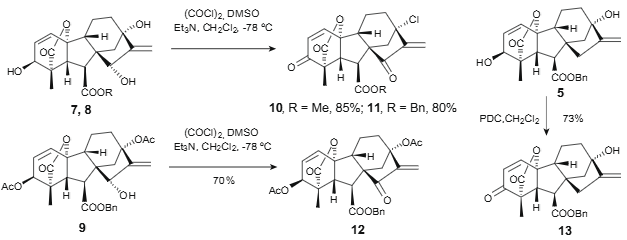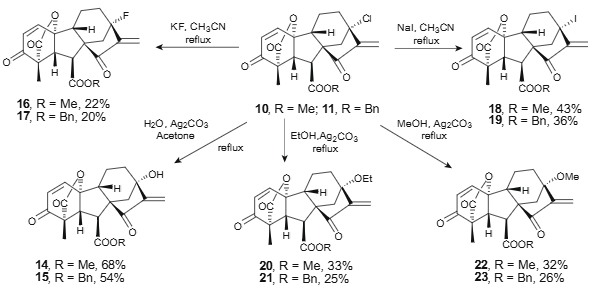Gibberellin
CAS number: 77-06-5
A class of plant growth hormone isolated from cultures of GIBBERELLA FUJIKUROI, a fungus causing Bakanae disease in rice. There are many different members of the family as well as mixtures of multiple members; all are diterpenoid acids based on the gibberellane skeleton.
Related images

Synthesis of gibberellin derivatives bearing α,β-unsaturated ketone moiety.

Synthesis of new gibberellin derivatives bearing α,β-unsaturated ketone moiety.
Related Questions and Answers
A: Endogenous hormone levels in rubber trees treated with GA3 and CCC show significant changes. GA3 treatment significantly increases endogenous GA3 and IAA levels, while CCC treatment increases endogenous GA3 levels but does not significantly affect IAA levels. CCC treatment also reduces endogenous ABA levels. These changes in hormone levels suggest that GA3 and CCC regulate flowering through different mechanisms, with GA3 promoting GA and IAA accumulation and CCC affecting GA and ABA levels. The study indicates that these hormonal changes contribute to the inhibition of flowering in rubber trees.
A: Gibberellin (GA) regulates flowering in rubber trees by modulating the expression of key genes involved in the GA signaling pathway and flowering regulation. Exogenous application of GA3 and the GA biosynthesis inhibitor chlormequat chloride (CCC) both inhibit flowering and reduce nutrient accumulation in inflorescences and leaves. Transcriptomic analysis revealed that GA3 and CCC treatments affect the expression of genes related to GA signal transduction, flowering regulation, and natural rubber biosynthesis. The findings suggest that GA signaling plays a critical role in inhibiting flowering in rubber trees, potentially offering a method to enhance latex production by reducing flowering events.
A: Exogenous gibberellin application via foliar feeding promotes rapid vegetative growth in kaffir lime seedlings. The optimal gibberellin concentration is 600ppm, which significantly increases leaf and flush size by 82% and 100%, respectively. However, it also results in a near threefold increase in spike size. Gibberellin application extends the flushing cycle by delaying leaf maturation, with higher concentrations prolonging developmental stages. This delay is linked to increased leaf morphometric response, potentially enhancing plant source capacity. The study concludes that gibberellin can accelerate recovery and enhance leaf-flushing in post-pruning kaffir lime seedlings, but its application also affects plant phenology by prolonging the flushing cycle.
A: GA3 treatment at 500 mg/L for 24 hours significantly increases the embryo formation rate in Lomatogonium rotatum seeds. The embryos gradually develop from the globular stage to the heart-shaped and torpedo-shaped stages, indicating that GA3 promotes embryo maturation and development.
A: Exogenous GA3 treatment significantly improves the germination rate, vigor index, and other germination traits of Lomatogonium rotatum seeds. It promotes seed germination by activating GA-responsive pathways and alleviating the inhibitory effects of ABA, thus initiating cell elongation and metabolic reactivation.